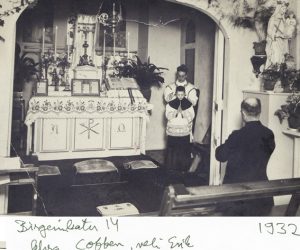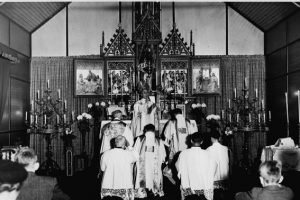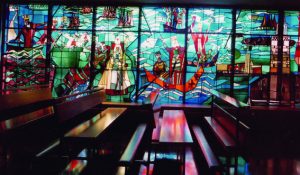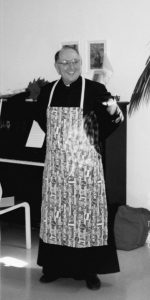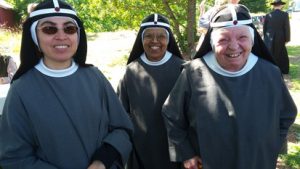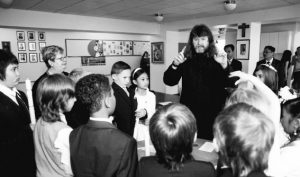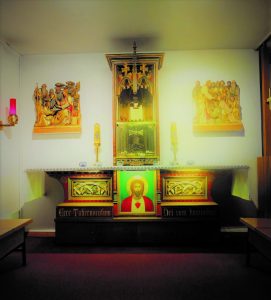SAINT BRIDGET AND
BLESSED HEMMING’S
Catholic Parish
·
TURKU 🇫🇮 FINLAND
·
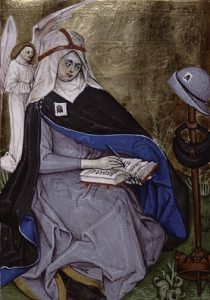
Parish History
BEFORE THE FOUNDATION OF THE PARISH
·
As a result of the reformation, the connections of the Church of Finland to catholicism were cut off from 1517, and catholicism was forbidden in the country for two hundred years. “Whoever turns to the pope’s doctrine, never has a home or residence within Swedish borders…”, was decreed in the Örebro parliament in 1617.
·
However, for the few catholic sailors, merchants and craftsmen who lived in Turku in the 18th century, establishing a parish in Turku was of paramount importance. The first known catholic pastoral mission in Turku was the visit of Paolo Moretti, Stockholm’s provicar, in the late summer of 1796. After the Finnish war between Russia and Sweden, a Russian army was deployed to Turku, including catholic soldiers. As far as possible, catholic priests of Vyborg visited Turku from February 1811 onwards.
·
Initially, Turku was part of Saint Henry’s parish in Helsinki. In 1890, 64 catholics lived in the Russian garrison area of Turku. The Polish military priest offered masses in the Betel Church in Turku. The sermon was given in Polish or Russian. Catholic soldiers had their own cemetery near the orthodox cemetery. Later, part of it was annexed for use by the catholic parish. At the beginning of the 20th century, a few Italian-born and German-born families came to Turku, and needed catholic pastoral care. In addition to these, the city was home to strolling Italian merchants and street organ grinders. German brewer Maximilian Heining worked at the Aura Brewery and contributed to the launch of mass being offered in Turku on a regular basis.
·
When the Finnish apostolic vicariate was founded in 1920, it improved the situation of the catholics of Turku. From 1922, Johannes van Gijsel, a parish priest, travelled to Turku about once a month. Masses were offered in the home of brewer Heining. There were usually about twenty parishioners present. The sermon was given in Swedish or German. Confessions were also heard in these languages.
·
PUISTOKATU 1
Puistokatu Street 1
·
The parish needed its own facilities. For this purpose, father Van Gijsel rented a modest wooden building near Martinsilta bridge (Puistokatu 1). The house was in disrepair, the chapel was frigid in winter, and the walls were covered with yellowed, tattered wallpaper. In this shack, a small group of faithful participated in the same holy mass that had been offered in the Turku Cathedral according to the Missale Aboense. The Puistokatu chapel was consecrated on June 17th, 1922 and was dedicated to Saint Bridget. Ever since, a monthly mass was offered regularly in the chapel. “There were usually about 30 people present, including a street organ grinder, a couple of ice cream salesmen, a few merchants with their families, a bazaar manager, and some German brewers.”
·
BIRGERINKATU 14 AND THE BIRTH OF AN INDEPENDENT PARISH
Birgerinkatu Street 14
·
The chapel on Puistokatu could not be considered a permanent solution, so the parish priest van Gijsel had to locate a new place for the parish. Such was found on Birgerinkatu, in the neighborhood of the present church. The name of the street today is Ursininkatu. The Birgerinkatu chapel was built by removing a wall between two rooms. The apartment also included a priest’s room and a kitchen. The priest’s room was later used as a vicar’s work and bedroom, as a sacristy, and as a guest room. At the same time, the kitchen was also the residence of a monastic brother, who acted as assistant to the vicar.
·
·
The chapel building was acquired and renovated in the first half of 1926. On June 3rd, the Feast of Corpus Christi, Van Gijsel offered the first mass there. Father Guliemus Cobben was appointed as parish priest in Turku, and preached there for the first time on September 26th, 1926. Father Cobben remained in Turku and began to keep his own church records. Until then, the parishioners had been members of the Helsinki parish. Thus, the Turku parish was eventually born.
·
Guliemus Cobben (b. 1897, d. 1985) was born in Holland and belonged to the order of the Sacred Heart Priests (SCJ). When he came to Turku, he was 29 years old. In the early years, he preached mainly in Swedish and German, because these languages were better understood by parishioners than Finnish. Vicar Cobben was a joyful, spontaneous, and benevolent young priest who without complaints settled for the cramped conditions of his rectory.
·
From 1931, brother Erik, a former sea captain, worked as an assistant to the parish priest. He cooked, repaired clothes, and served at mass. Because food expenses had to be minimized, meals were modest and the health of the vicar declined. Vicar Cobben’s time as parish priest in Turku lasted nearly eight years. In 1934, Cobben was appointed apostolic vicar, and was consecrated as bishop in the Netherlands. The parishioners rejoiced in the appointment, but were saddened by losing their beloved parish priest.
·
BIRGERINKATU 15
Birgerinkatu Street 15
·
The second vicar of the parish was Laurentius Holzer (b. 1897, d. 1978). Arriving in 1922, he was a Dutch parish priest and was not affiliated with an order. He was regarded as a skilled economist and architect, skills which were necessary in the Turku parish. The inauguration was celebrated on August 4th, 1935. The parish priest immediately went to the Netherlands to raise money and, upon returning, traded the plot of land on Birgerinkatu 15. The purchase price was 395,000 marks, and the bank loan was to be 350,000 marks with interest and amortization to be paid by lotteries, collections, and various business transactions. The new chapel was completed quickly, and the inauguration was held on the Feast of Pentecost, on the last of May, 1936.
·
·
Compared to the previous, Birgerinkatu 15’s chapel was spacious and beautiful. A cabinet altar decorated with wood sculptures was a gift from Dutch monastic sisters. To relieve the debt burden of the parish, the vicar made long trips to Europe in order to raise money. As the political situation became turbulent in the autumn of 1939, many parishioners moved to Germany or Sweden, some even as far as to Italy. Still others moved from the city to the countryside to protect themselves from bombings.
·
During the Winter War, only the morning masses were offered in the chapel. Living in the rectory was hazardous, as the bomb shelter was not nearby, and the the railway station (often targeted by the enemy) was almost next door. Thus, the parish priest moved to Kristiinankatu, which was a somewhat safer living arrangement. When it was difficult to raise money for operating the parish during the war, vicar Holzer tried to find other ways. He made toys out of pieces of boards that were then sold in Wilhelm Casagrande’s store. The products were well-traded, but the company’s operations were discontinued after the bishop pointed out that such a business pursuit was not suitable for a priest.
·
After the end of World War II, the vicar went back to his fundraising and also travelled to Rome. Here he clarified his business activity to the pope’s secretary, which resulted in the Vatican’s approval. Visiting the Netherlands, he received $10,000 in aid from the Order of the Sacred Heart, and spent the entire sum on tulip bulbs. When the tulips arrived in Finland, he sold them at an auction in Helsinki for $50,000. Next, Holzer imported rice and oranges. He sold the delicacies at a lucrative price, and by these means was able to pay for the building debts of the Turku chapel. With the remaining money, he built a three-story house for the sisters’ orphanage and kindergarten in the late 1940s. The parish priest created drawings of the new building by himself and also worked as a builder. The building was ready for use in August 1949.
·
Five sisters of the Order of the Sacred Heart settled in the house, after which the orphanage opened its doors. At the beginning, there were about 30 children in the orphanage and up to 80 pupils in the kindergarten. The appearance of the black-veiled sisters was an unusual sight in Turku, and they were interviewed in the papers. The orphanage stopped operating in the 1950s when it became unnecessary, but the kindergarten functioned until spring 1984.
·
Father Jan Snijders (b. 1912, d. 1972) was the vicar from 1949 to 1967. He was also born in the Netherlands. Snijders wanted to enrich the spiritual life of the parish and form a single family out of his scattered flock. Many felt that his term of office was a time of spiritual growth. He sought to develop the choir and was also interested in working with children and youth. When his energy declined, he decided to serve in hospital ministry in Germany.
·
BUILDING A NEW CHURCH
·
In 1966 there were 225 members in the parish and 157 of them were Finnish citizens. The number of Finnish-speaking parishioners grew sluggishly. Meanwhile, many of the originally foreignspeaking families were fennicized. The last mass in the Ursininkatu 15 wood chapel was offered on January 6th, 1966. Only a few weeks later, the building was demolished. The masses then took place in the chapel of the sisters’ house until the new church was completed.
·
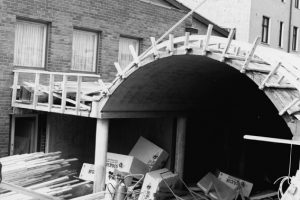
Main Entrance of the Convent
·
The drawings of the present Saint Bridget and Blessed Hemming Church were drawn up by the architect A.S. Sandel and the project funding was taken care of by Holzer this time as well. The new church was inaugurated on November 5th, 1966.
·
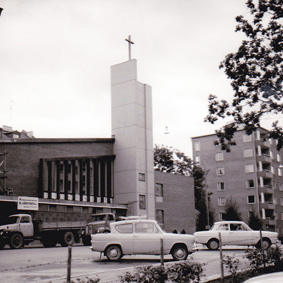
·
The stained glass and other art objects are the work of father J. De Visser. On the wall behind the altar there was initially a large crucifix made of wrought iron and steel, and there were six copper candlesticks beside the altar. On the back wall, there were pictures of the church’s patrons, Saint Bridget and Blessed Hemming. The baptismal font was located in the side chapel.
·
